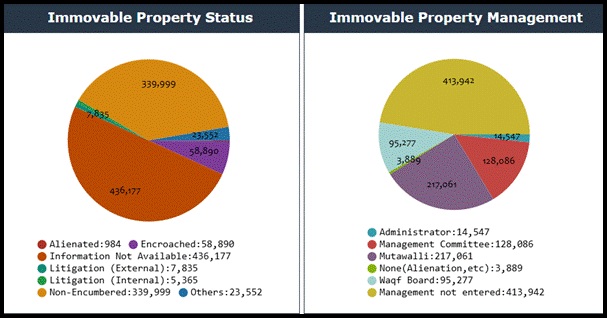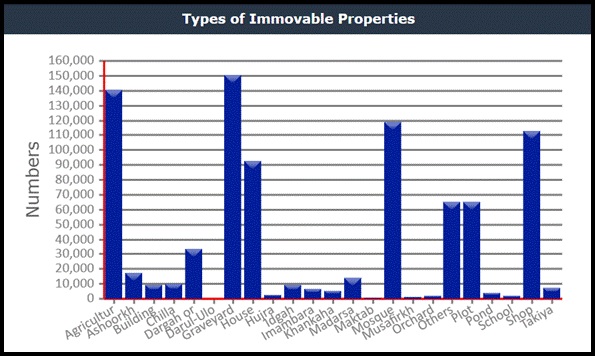Ministry of Minority Affairs
Waqf Amendment Bill, 2025: The History of Waqf in India
प्रविष्टि तिथि:
03 APR 2025 6:55PM by PIB Delhi
‘Waqf’ has been defined as the permanent dedication by any person of any movable or immovable property for any purpose recognised by Muslim Law as pious, religious or charitable.[1]
Introduction
India has been working to regulate and protect Waqf properties, which have religious, social, and economic significance. The first major law, the Waqf Act of 1954, laid the foundation for managing these properties. Over time, laws have been updated to improve governance and prevent misuse. The Waqf Amendment Bill 2025 aims to increase transparency, strengthen management, and protect Waqf assets. These reforms follow global best practices.
The Waqf Act of 1995, enforced by the Central Government, currently regulates Waqf properties. The main administrative bodies are:
- Central Waqf Council (CWC) – Advises the government and State Waqf Boards on policy but does not directly control Waqf properties.
- State Waqf Boards (SWBs) – Manage and protect Waqf properties in each state.
- Waqf Tribunals – Exclusive judicial bodies that handle disputes related to Waqf properties.
This system ensures better management and faster resolution of issues. Over the years, legal changes have made Waqf administration more transparent, efficient, and accountable.
An Overview of Waqf History in India
Waqf properties in India have been regulated by several laws to improve administration and prevent mismanagement:
- The Mussalman Wakf Validating Act, 1913:
- Allowed Muslims to create Waqfs for family benefit, eventually leading to charitable purposes.
- Aimed to improve Waqf management but was not very effective.
- The Mussalman Wakf Act, 1923: Introduced rules for proper accounting and transparency in Waqf management.
- The Mussalman Wakf Validating Act, 1930: Strengthened the legal validity of family Waqfs, giving legal backing to the 1913 Act.
- The Wakf Act, 1954:
- Created State Waqf Boards (SWBs) for the first time to oversee Waqf properties.
- Strengthened Waqf management after India's independence.
- Established the Central Waqf Council of India in 1964 to supervise State Waqf Boards and provided a pathway toward the centralisation of Waqfs.
- This central body oversees the work under various state Waqf boards which were established under provisions of Section 9(1) of the Waqf Act, 1954.
- Amendments to the Wakf Act, 1954 (1959, 1964, 1969, and 1984): These amendments aimed to further improve the administration of waqf properties.
- The Waqf Act, 1995: This comprehensive Act repealed the 1954 Act and its amendments:
- This was enacted to govern the administration of Waqf Properties in India.
- It provides for the power and functions of the Waqf Council, the State Waqf Boards, and the Chief Executive Officer, and also the duties of mutawalli.
- Created Waqf Tribunals, special courts with powers similar to civil courts.
- Tribunal decisions are final and cannot be challenged in civil courts.
- The Waqf (Amendment) Act, 2013 introduced significant changes including:
- Created three-member Waqf Tribunals, including a Muslim law expert.
- Required two women members on each State Waqf Board.
- Prohibited the sale or gifting of Waqf properties.
- Increased the lease period of Waqf properties from 3 years to 30 years for better use.
- Waqf (Amendment) Bill, 2025, and the Mussalman Wakf (Repeal) Bill, 2024
- Aims to modernize Waqf administration, reduce legal disputes, and improve efficiency.
- Seeks to fix issues in the 1995 Act and the 2013 Amendment.
Schemes by the Ministry of Minority Affairs
The Quami Waqf Board Taraqqiati Scheme (QWBTS) and Shahari Waqf Sampatti Vikas Yojana (SWSVY) are being implemented through the Ministry of Minority Affairs (MoMA), Government of India. These two schemes are for automation and modernization of State Waqf Boards.
- Under QWBTS, Government Grants-in-Aid (GIA) is provided to State Waqf Boards through CWC for the deployment of manpower to computerize and digitize records of waqf properties and to enhance the administration of Waqf Boards.
- SWSVY offers interest-free loans to Waqf Boards and institutions to develop commercial projects on Waqf properties.
- Rs 23.87 crore and Rs 7.16 crore respectively were spent under QWBTS and SWSVY from 2019-20 to 2023-24.[2]
Overview of Waqf Properties in India:
As per data available on WAMSI portal 30 States/UTs and 32 Boards reported that there are 8.72 lakh properties, covering an area of more than 38 lakh acres. Out of the 8.72 lakh properties, 4.02 lakhs are Waqf by user. For remaining Waqf properties, the Ownership Rights Establishing Documents (deeds) have been uploaded on the WAMSI Portal for 9279 cases and only 1083 Waqf deeds have been uploaded.



(As of March 14, 2025)
Source: https://wamsi.nic.in/wamsi/dashBoardAction.do;jsessionid=40F3DA0F79ED801CE30802EB0F326394?method=totalRegisteredProp
Data on State-wise numbers and area of Waqf properties (as of September 2024)
|
Sr. No.
|
State Waqf Boards
|
Total No. of Properties
|
Total area in Acre
|
|
1
|
Andaman and Nicobar Waqf Board
|
151
|
178.09
|
|
2
|
Andhra Pradesh State Waqf Board
|
14685
|
78229.97
|
|
3
|
Assam Board of Waqfs
|
2654
|
6618.14
|
|
4
|
Bihar State (Shia) Waqf Board
|
1750
|
29009.52
|
|
5
|
Bihar State (Sunni) Waqf Board
|
6866
|
169344.82
|
|
6
|
Chandigarh Waqf Board
|
34
|
23.26
|
|
7
|
Chhattisgarh State Waqf Board
|
4230
|
12347.1
|
|
8
|
Dadra and Nagar Haveli Waqf Board
|
30
|
4.41
|
|
9
|
Delhi Waqf Board
|
1047
|
28.09
|
|
10
|
Gujarat State Waqf Board
|
39940
|
86438.95
|
|
11
|
Haryana Waqf Board
|
23267
|
36482.4
|
|
12
|
Himachal Pradesh Waqf Board
|
5343
|
8727.6
|
|
13
|
Jammu and Kashmir Auqaf Board
|
32533
|
350300.75
|
|
14
|
Jharkhand State (Sunni) Waqf Board
|
698
|
1084.76
|
|
15
|
Karnataka State Board of Auqaf
|
62830
|
596516.61
|
|
16
|
Kerala State Waqf Board
|
53282
|
36167.21
|
|
17
|
Lakshadweep State Waqf Board
|
896
|
143.81
|
|
18
|
Madhya Pradesh Waqf Board
|
33472
|
679072.39
|
|
19
|
Maharashtra State Board of Waqfs
|
36701
|
201105.17
|
|
20
|
Manipur State Waqf Board
|
991
|
10077.44
|
|
21
|
Meghalaya State Board of Waqfs
|
58
|
889.07
|
|
22
|
Odisha Board of Waqfs
|
10314
|
28714.65
|
|
23
|
Puducherry State Waqf Board
|
693
|
352.67
|
|
24
|
Punjab Waqf Board
|
75965
|
72867.89
|
|
25
|
Rajasthan Board of Muslim Waqfs
|
30895
|
509725.57
|
|
26
|
Tamil Nadu Waqf Board
|
66092
|
655003.2
|
|
27
|
Telangana State Waqf Board
|
45682
|
143305.89
|
|
28
|
Tripura Board of Waqfs
|
2814
|
1015.73
|
|
29
|
U.P. Shia Central Board of Waqfs
|
15386
|
20483
|
|
30
|
U.P. Sunni Central Board of Waqfs
|
217161
|
|
|
31
|
Uttarakhand Waqf Board
|
5388
|
21.8
|
|
32
|
West Bengal Board of Waqfs
|
80480
|
82011.84
|
|
|
Total
|
872328
|
3816291.788
|
Conclusion:
The changes in Waqf laws in India from 1913 to 2024 show a strong effort to protect and manage Waqf properties for society’s benefit while ensuring a proper administration system. Each law aimed to solve current problems while keeping the main purpose of Waqf endowments. The Waqf Amendment Bill 2025 is an important step toward making Waqf management more transparent, responsible, and inclusive.
Kindly find the pdf file
***
Santosh Kumar/ Ritu Kataria/ Kritika Rane
(रिलीज़ आईडी: 2118415)
आगंतुक पटल : 106846